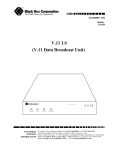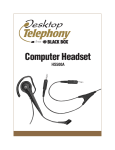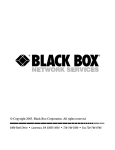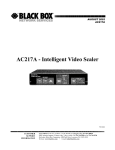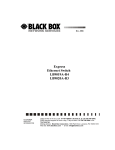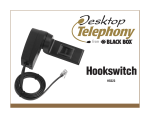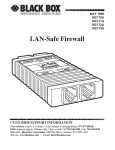Download Fiber Driver
Transcript
MD940A-FSM MD940AE-FSM MD940A-FST MD940AE-FST APRIL 2000 MD940A-MSM MD940AE-MSM MD940A-MST MD940AE-MST Fiber Driver FI B E R D R IV E R IN P U T O U TP U T CUSTOMER SUPPORT INFORMATION DCE DTE PWR Order toll-free in the U.S. 24 hours, 7 A.M. Monday to midnight Friday: 877-877-BBOX FREE technical support, 24 hours a day, 7 days a week: Call 724-746-5500 or fax 724-746-0746 Mail order: Black Box Corporation, 1000 Park Drive, Lawrence, PA 15055-1018 Web site: www.blackbox.com • E-mail: [email protected] FCC AND IC STATEMENTS FEDERAL COMMUNICATIONS COMMISSION AND INDUSTRY CANADA RADIO FREQUENCY INTERFERENCE STATEMENTS This equipment generates, uses, and can radiate radio frequency energy and if not installed and used properly, that is, in strict accordance with the manufacturer’s instructions, may cause interference to radio communication. It has been tested and found to comply with the limits for a Class A computing device in accordance with the specifications in Subpart J of Part 15 of FCC rules, which are designed to provide reasonable protection against such interference when the equipment is operated in a commercial environment. Operation of this equipment in a residential area is likely to cause interference, in which case the user at his own expense will be required to take whatever measures may be necessary to correct the interference. Changes or modifications not expressly approved by the party responsible for compliance could void the user’s authority to operate the equipment. This digital apparatus does not exceed the Class A limits for radio noise emission from digital apparatus set out in the Radio Interference Regulation of Industry Canada. Le présent appareil numérique n’émet pas de bruits radioélectriques dépassant les limites applicables aux appareils numériques de la classe A prescrites dans le Règlement sur le brouillage radioélectrique publié par Industrie Canada. 1 FIBER DRIVER NORMAS OFICIALES MEXICANAS (NOM) ELECTRICAL SAFETY STATEMENT INSTRUCCIONES DE SEGURIDAD 1. Todas las instrucciones de seguridad y operación deberán ser leídas antes de que el aparato eléctrico sea operado. 2. Las instrucciones de seguridad y operación deberán ser guardadas para referencia futura. 3. Todas las advertencias en el aparato eléctrico y en sus instrucciones de operación deben ser respetadas. 4. Todas las instrucciones de operación y uso deben ser seguidas. 5. El aparato eléctrico no deberá ser usado cerca del agua—por ejemplo, cerca de la tina de baño, lavabo, sótano mojado o cerca de una alberca, etc.. 6. El aparato eléctrico debe ser usado únicamente con carritos o pedestales que sean recomendados por el fabricante. 7. El aparato eléctrico debe ser montado a la pared o al techo sólo como sea recomendado por el fabricante. 8. Servicio—El usuario no debe intentar dar servicio al equipo eléctrico más allá a lo descrito en las instrucciones de operación. Todo otro servicio deberá ser referido a personal de servicio calificado. 9. El aparato eléctrico debe ser situado de tal manera que su posición no interfiera su uso. La colocación del aparato eléctrico sobre una cama, sofá, alfombra o superficie similar puede bloquea la ventilación, no se debe colocar en libreros o gabinetes que impidan el flujo de aire por los orificios de ventilación. 10. El equipo eléctrico deber ser situado fuera del alcance de fuentes de calor como radiadores, registros de calor, estufas u otros aparatos (incluyendo amplificadores) que producen calor. 11. El aparato eléctrico deberá ser connectado a una fuente de poder sólo del tipo descrito en el instructivo de operación, o como se indique en el aparato. 2 NOM STATEMENT 12. Precaución debe ser tomada de tal manera que la tierra fisica y la polarización del equipo no sea eliminada. 13. Los cables de la fuente de poder deben ser guiados de tal manera que no sean pisados ni pellizcados por objetos colocados sobre o contra ellos, poniendo particular atención a los contactos y receptáculos donde salen del aparato. 14. El equipo eléctrico debe ser limpiado únicamente de acuerdo a las recomendaciones del fabricante. 15. En caso de existir, una antena externa deberá ser localizada lejos de las lineas de energia. 16. El cable de corriente deberá ser desconectado del cuando el equipo no sea usado por un largo periodo de tiempo. 17. Cuidado debe ser tomado de tal manera que objectos liquidos no sean derramados sobre la cubierta u orificios de ventilación. 18. Servicio por personal calificado deberá ser provisto cuando: A: El cable de poder o el contacto ha sido dañado; u B: Objectos han caído o líquido ha sido derramado dentro del aparato; o C: El aparato ha sido expuesto a la lluvia; o D: El aparato parece no operar normalmente o muestra un cambio en su desempeño; o E: El aparato ha sido tirado o su cubierta ha sido dañada. 3 FIBER DRIVER Contents 1. Specifications . . . . . . . . . . . . . . . . . . . . . . . . . . . . . . . . . . . . . . . . . . . . . . . . 5 2. Introduction . . . . . . . . . . . . . . . . . . . . . . . . . . . . . . . . . . . . . . . . . . . . . . . . . 6 2.1 Description . . . . . . . . . . . . . . . . . . . . . . . . . . . . . . . . . . . . . . . . . . . . . . . 6 2.2 Typical Application . . . . . . . . . . . . . . . . . . . . . . . . . . . . . . . . . . . . . . . . 6 3. Installation . . . . . . . . . . . . . . . . . . . . . . . . . . . . . . . . . . . . . . . . . . . . . . . . . . 7 3.1 Installing the Fiber Driver . . . . . . . . . . . . . . . . . . . . . . . . . . . . . . . . . . . 7 3.2 Connectors . . . . . . . . . . . . . . . . . . . . . . . . . . . . . . . . . . . . . . . . . . . . . . . 8 3.3 Pinning . . . . . . . . . . . . . . . . . . . . . . . . . . . . . . . . . . . . . . . . . . . . . . . . . . 9 3.4 Jumpers . . . . . . . . . . . . . . . . . . . . . . . . . . . . . . . . . . . . . . . . . . . . . . . . . . 9 4 CHAPTER 1: Specifications 1. Specifications Flow Control—Passes XON/XOFF; does not support hardware handshaking Data Rate—76.8 kbps via 100 micron-core cable Transmission Distance—Up to 3.5 km via 100 micron-core cable with different range selections to optimize specific installations Switches—DCE/DTE (toggle) Interface—EIA RS-232 with switch-selectable DTE/DCE; optical fiber interface Connectors—MD940A(E)-FSM: (1) DB25 female, (2) SMA-type optical fiber; MD940A(E)-FST: (1) DB25 female, (2) ST; MD940A(E)-MSM: (1) DB25 male, (2) SMA; MD940A(E)-MST: (1) DB25 male, (2) ST Power—MD940A models: 115 VAC, 60 Hz, 65 mA; MD940AE models: Input: 100 to 240 VAC, 50 to 60 Hz (autosensing), up to 200 mA; Output: +5 VDC at 1 amp NOTE The power supply used for the MD940AE models is designed to accept a detachable input cord with a plug appropriate for standard housevoltage outlets in your region. If you need to replace it, you can use our PS112E power supply. Size—0.9"H x 1.75"W x 3.9"D (2.3 x 4.4 x 9.9 cm) Weight—1 lb. (0.5 kg) 5 FIBER DRIVER 2. Introduction 2.1 Description The Fiber Driver is an asynchronous, bi-directional data converter. The Fiber Driver changes standard EIA RS-232 signals into light pulses for high-speed transmission via optical fiber cable between two asynchronous RS-232 devices. At the remote end of your transmission, a second (remote) Fiber Driver is used to convert the optical signals back to RS-232 signals. (The Fiber Drivers should be used in pairs.) The Fiber Driver uses XON/XOFF flow control. Eight models are available: four models feature a DB25 female connector for RS-232 signals and either two SMA or two ST connectors; the other four models feature a DB25 male connector for RS-232 signals and either two SMA or ST connectors. 2.2 Typical Application Fiber optic cable Asynchronous minicomputer Fiber Drivers Asynchronous terminal Figure 1. Typical Application of the Fiber Driver. 6 CHAPTER 3: Installation 3. Installation 3.1 Installing the Fiber Driver 1. Before connecting the optical fiber cable, remove the protective dust caps from the tips of the connectors; do not touch the tips of the connectors with your fingers. Save these dust caps for future use. 2. Wipe clean the ends of the connectors with a soft cloth or lint-free lens tissue dampened in alcohol (Ethanol). Make certain they’re clean before attaching the cable to the connectors. 3. Find the serial port (the RS-232 port) on the local device. 4. Determine whether the device is data communications equipment (DCE) or data terminal equipment (DTE). Refer to the manufacturer’s instruction manual to determine DTE and DCE configuration. 5. Set the DCE/DTE toggle switch on the Driver to the same setting as the host device. 6. Repeat this procedure for the remote device. 7. Install fiber optic cable between the two Fiber Drivers. Fiber optic cable is immune to electrical interference and is ideal to use in harsh environments (such as outdoor cable runs, manufacturing plants, etc.). Be careful to avoid damaging the cable’s glass-fiber core. Never create kinks or folds in the cable, avoid bending the cable at sharp angles, and do not stretch of place excessive tension on the cable. 8. Install the fiber optic cable so that the transmit port on the local Driver is connected to the receive port of the remote Driver. Connect the receive port of the local Driver to the transmit port of the remote Driver. Use coded duplex fiber optic cable to simplify installation. 9. Install the power supply units for each Driver. Plug the power cord into a 115-VAC outlet (for MD840A models) or 110- to 240-VAC outlet (for MD840AE models). Then insert the “mini-phone” plugs into the Power connector on the Driver. 7 FIBER DRIVER NOTE During installation , you MUST maintain a correct pairing of optical fiber cables. The duplex fiber optic cable is coded using either color bands at regular intervals or tabs labeled “A” and “B.” You must use the coded strands on relevant ports for both devices. For example, you must make a connection from the Transmit port (TX) on one Fiber Driver to the Receive port (RX) on the other Fiber Driver. Be sure to monitor the path and direction of the color-coded fiber strands during installation to ensure a proper connection. You will make two Transmit-to-Receive connections with the optical fiber cable. 3.2 Connectors The type of connectors used to terminate the duplex optical fiber cables in your network installation will depend on the which model of the Fiber Driver you have purchased. • If you have the MD940A(E)-FSM or MD940A(E)-MSM, use SMA 905 connectors. • If you have the MD940A(E)-FST or MD940A(E)-MST, use ST connectors. Secure the connectors by making them “finger-tight.” ST Connectors (MD940A-FST, MD940AE-FST, MD940A-MST, MD940AE-MST) ST connectors are similar to BNC connectors: they require a “push-and-twist” motion to make a connection. Place one hand on the Fiber Driver; grasp the cable in your other hand. Push the connector on the end of the cable into the connector on the Driver, then twist a quarter-turn to lock the connectors into position. SMA Connectors (MD940A-FSM, MD940AE-FSM, MD940A-MSM, MD940AE-MSM) SMA connectors thread together. Place one hand on the Driver; grasp the cable in your other hand. Place the connector on the end of the cable (“female” threads) over the connector on the Driver (“male” threads), then turn a few times to lock the connectors into position. CAUTION Do not use a tool (such as a wrench) to tighten the SMA connectors. Using any type of tool to tighten a fiber optic connector will probably damage your Fiber Driver. Don’t use excessive force when tightening the fiber optic connectors (SMA or ST). When the connection is finger tight, it’s right. 8 CHAPTER 3: Installation 3.3 Pinning The RS-232 connector contains the following internal connections: Pin 4 to Pin 5 Pin 8 to Pin 20 Pin 6 is connected to +5 volts through a factory-installed internal jumper. 3.4 Jumpers Figure 2 shows the location of jumpers W1, W2, and W3 on the board. Table 1 describes the functions of the jumpers. R3 R1 W1 W2 U3 R8 C8 R7 U4 U2 J2 ABC W3 U1 S1 D2 D1 Figure 2. Printed Circuit Board Layout for the Fiber Driver. 9 FIBER DRIVER Table 1. Functions of Jumpers W1, W2, and W3 Jumper Function Use W1 Pull up to +5 VDC Install to enable pin 6 of the RS-232 connector. W2 High-speed filter Install when operating at high data rates (greater than 19.2 kbps). W3 *Range select A=short range; B=medium range; C=long range *Range selection depends on the size of the fiber optic cable you’re using and the distance data is transmitted. Select the shortest range that accurately passes data. 10 TRADEMARKS TRADEMARKS USED IN THIS MANUAL ST® is a registered trademark of American Telephone and Telegraph Company. Any other trademarks mentioned in this manual are acknowledged to be the property of the trademark owners. 11 NOTES © Copyright 2000. Black Box Corporation. All rights reserved. 1000 Park Drive • Lawrence, PA 15055-1018 • 724-746-5500 • Fax 724-746-0746















